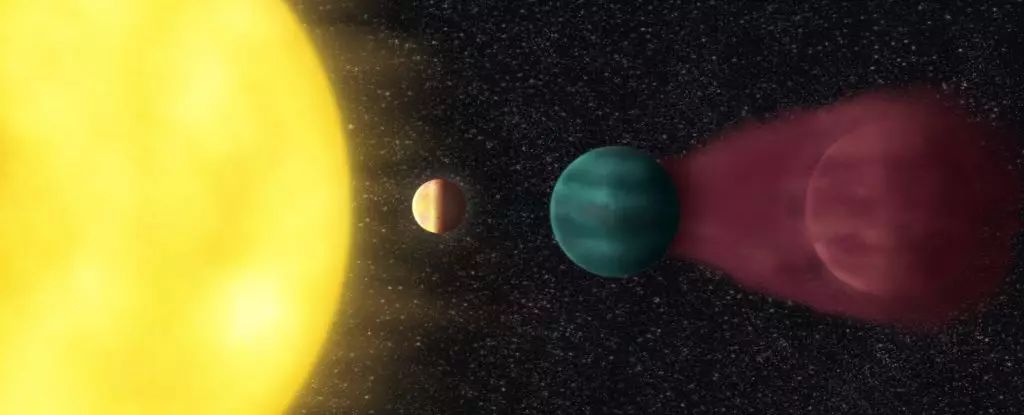An exoplanet discovered a mere 73 light-years away has unlocked a portal into the distant past of our own planet. Named HD 63433 d, this newborn cosmic body bears a striking resemblance to a young Earth, trapped in a tightly-wound orbit around a Sun-like star. While Earth remains the sole known celestial abode teeming with life, the investigation of Earth-like exoplanets facilitates an understanding of the conditions necessary for life to flourish elsewhere in the boundless Universe. HD 63433 d, with its similarities to and deviations from Earth, promises to provide invaluable insights into our planet’s formative years.
A Glimpse into the Extraordinary
While sharing attributes with Earth, HD 63433 d veers into thrillingly extreme territories, making it all the more intriguing to scientists. “It’s a useful planet because it may be like an early Earth,” remarks astrophysicist Melinda Soares-Furtado from the University of Wisconsin-Madison, who spearheaded the exploratory research alongside astronomer Benjamin Capistrant from the University of Florida. Consequently, this proximity enables us to examine supplementary data regarding outgassing and atmospheric erosion—crucial factors influencing the evolution of terrestrial worlds. Fascinatingly, this is where HD 63433 d deviates dramatically from our home planet.
HD 63433 d, an Earth-sized exoplanet, was detected during a comprehensive TESS survey—an exoplanet-hunting telescope meticulously monitoring the fluctuations of starlight to identify potential orbiting exoplanets. The variations in the star’s light emissions provide essential data regarding the exoplanet’s dimensions and mass. The host star, HD 63433, mirrors the Sun in size, mass, and temperature. However, the stellar system is significantly younger, with an estimated age of slightly over 400 million years, compared to the Sun’s venerable age of 4.5 billion years. Thus, both HD 63433 and its exoplanets are considered celestial infants. The observation thus far has revealed the presence of three exoplanets orbiting this star—a pair of mini-Neptunes found in 2020, and the latest discovery of HD 63433 d.
Through the meticulous examination of transit data, astronomers deduced that HD 63433 d is approximately 1.1 times the radius of Earth. Although the exoplanet’s mass remains undisclosed, its physical dimensions strongly suggest a terrestrial composition akin to planets such as Earth, Mars, or Venus—rocky worlds capable of harboring life. HD 63433 d whirls around its host star in an extraordinarily tight loop, completing one orbit every 4.2 days. This proximity implies that HD 63433 d is likely tidally locked, with one hemisphere perpetually facing its scorching star. Consequently, the surface of the illuminated side is forever immersed in a glowing, molten sea of liquid rock—a monumental lava ocean.
Mirroring the Moon’s Fiery Tempest
While Earth never endured such an intimate relationship with the Sun, it did experience extreme temperatures following the catastrophic moon-forming impact. The scorching heat from this event likely propelled temperatures on Earth as high as 2,300 Kelvin. This comparison underscores the significance of HD 63433 d as an invaluable proxy for studying Earth’s turbulent past. Although numerous inquiries regarding HD 63433 d still persist, the research team optimistically anticipates additional studies that will unveil further revelations about this enigmatic exoplanet. Determining its mass will enable astronomers to calculate its density and eventually ascertain its exact composition. The presence and composition of HD 63433 d’s atmosphere remain shrouded in mystery, eagerly awaiting detailed investigations.
Our Celestial Neighborhood
Astrophysicist Melinda Soares-Furtado exclaims, “This is our solar backyard, and that’s kind of exciting.” Accordingly, studying a star so close, with a relatively populated neighboring system, opens up a plethora of possibilities. The wealth of knowledge yielded from HD 63433 d has immense implications for our quest to identify habitable planets among the approximately 100 other similar stars comprising this youthful cluster. As we embark on this enthralling pursuit, HD 63433 d stands as the closest known exoplanet akin to Earth in terms of size and orbit, orbiting a youthful star. Inevitably, there is much this fantastical world has yet to display, and we eagerly await the forthcoming discoveries that science will unveil in the coming months.

Leave a Reply